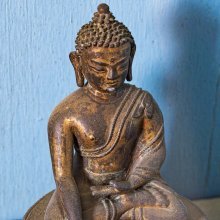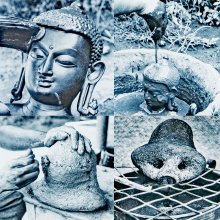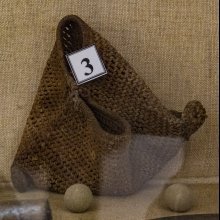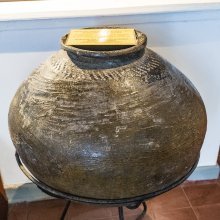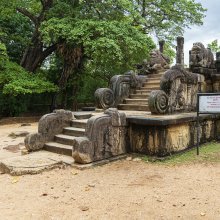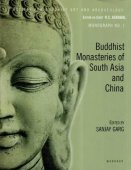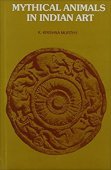Clay: 4 definitions
Introduction:
Clay means something in Hinduism, Sanskrit. If you want to know the exact meaning, history, etymology or English translation of this term then check out the descriptions on this page. Add your comment or reference to a book if you want to contribute to this summary article.
Images (photo gallery)
(+38 more images available)
In Hinduism
Natyashastra (theatrics and dramaturgy)
Source: Shodhganga: Elements of Art and Architecture in the Trtiyakhanda of the Visnudharmottarapurana (natya)Clay is used as a material for creating artificial masks (of gods, demons, animals, etc.) in Indian Dramas, as part of the Prasta division of Āhāryābhinaya: one of the four divisions of Abhinaya or “ways to convey or represent one’s emotion to others”, according to the Viṣṇudharmottarapurāṇa, an ancient Sanskrit text which (being encyclopedic in nature) deals with a variety of cultural topics such as arts, architecture, music, grammar and astronomy.—The Viṣṇudharmottarapurāṇa says that Prasta denotes the making of artificial masks of gods, demons, demi-gods, different animals and birds etc. by clay, wood, cloth, leather and iron. In the Nāṭyaśāstra, the word pusta is used instead of prasta.

Natyashastra (नाट्यशास्त्र, nāṭyaśāstra) refers to both the ancient Indian tradition (shastra) of performing arts, (natya—theatrics, drama, dance, music), as well as the name of a Sanskrit work dealing with these subjects. It also teaches the rules for composing Dramatic plays (nataka), construction and performance of Theater, and Poetic works (kavya).
Vastushastra (architecture)
Source: Shodhganga: Elements of Art and Architecture in the Trtiyakhanda of the Visnudharmottarapurana (vastu)Clay is the primary ingredient for creating Bricks which is an important Material used for the Construction of Walls and Temples, according to the Viṣṇudharmottarapurāṇa, an ancient Sanskrit text which (being encyclopedic in nature) deals with a variety of cultural topics such as arts, architecture, music, grammar and astronomy.—In ancient time bricks used to be made of clay which were of four kinds, ūṣara, pāṇḍura, kṛṣṇacikkaṇa and tāmraputtaka. According to the Mayamata, tāmraputtaka type of clay is the best one for making of bricks.

Vastushastra (वास्तुशास्त्र, vāstuśāstra) refers to the ancient Indian science (shastra) of architecture (vastu), dealing with topics such architecture, sculpture, town-building, fort building and various other constructions. Vastu also deals with the philosophy of the architectural relation with the cosmic universe.
Shilpashastra (iconography)
Source: archive.org: Catalogue of Pancaratra Agama Texts (shilpa)1) Clay is denoted by the Sanskrit term Mṛt and represents a material for making icons, as discussed in chapter 5 of the Markandeya-Samhita: a Pancaratra text comprising some 2200 Sanskrit verses mainly dealing with temple-building, iconography, puja (worship procedures), utsava (festivities) and prayashcitta (expiatory measures).—Description of chapter [mṛt-saṃskāra-vidhi]: The clay to be used when fashioning an icon out of plaster will vary according to the caste of the person undertaking to sponsor its construction and installation—white clay will be used when the patron is a Brahmin, red clay when a Kṣatriya, yellow clay when a Vaiśya and black clay when a Śudra. [...]
2) Clay refers to one of the materials which can be used for making icons (pratimā), as discussed in chapter 14 of the Vishnu-Samhita: a Sanskrit text written in 2600 verses which covers typical Pancaratra topics through a narrative dialogue between Aupagayana and Siddha Sumati.—Description of the chapter [pratimā-lakṣaṇa]: Icons may be made from gems, metals, stone, colored stones [dhātu], clay, wood—or one may be represented by a painted picture (1-2). Stones for images are to be gathered from certain places only, and should be selected according to specific classifications or desirable qualities (3-27); the ritual procedures for doing this are given (28-46). [...]
3) Clay refers to a material for creating “icons” (pratimā), as discussed in chapter 7 of the Brahma-ratra section of the Sanatkumara-Samhita: an encyclopedic Sanskrit text written in over 3500 verses dealing with a variety of topics such as yoga, temple-building, consecration ceremonies, initiation and dhanurveda (martial arts).—Description of the chapter [pratimā-lakṣaṇa-uddeśa]: Icons may be made of stone, metal, gems, wood or clay. As for stones, these are classified into four groups-named according to the four castes—and it is told which kinds should be used for making proper icons. The discussion includes details about measurements, mistakes to be avoided in fashioning various parts of the icon, what evil effects will come from such defects, etc. (1-75.). [...]
Source: Shodhganga: Elements of Art and Architecture in the Trtiyakhanda of the Visnudharmottarapurana (shilpa)Clay in used as a basic ingredient in the process of creating a Canvas, in the ancient Indian art of Painting (citra), according to the Viṣṇudharmottarapurāṇa, an ancient Sanskrit text which (being encyclopedic in nature) deals with a variety of cultural topics such as arts, architecture, music, grammar and astronomy.—In the Viṣṇudharmottarapurāṇa, it is suggested that before going to start Painting on walls one should plaster a wall. For the process of kuḍya i.e., plastering on a wall, the painter needs iṣṭakācūrṇa i.e., powder of bricks and mṛd i.e., clay as basic ingredients. To prepare this at first the powder of three kinds of brick and one third of clay should be mixed.

Shilpashastra (शिल्पशास्त्र, śilpaśāstra) represents the ancient Indian science (shastra) of creative arts (shilpa) such as sculpture, iconography and painting. Closely related to Vastushastra (architecture), they often share the same literature.
See also (Relevant definitions)
Starts with: Claytonia lanceolata, Claytonia multicaulis, Claytonia perfoliata, Claytonia sibirica, Claytonia tuberosa, Claytonia virginica.
Query error!
Full-text (+804): Mrittika, Mrid, Gopicandana, Karda, Mritpinda, Putapaka, Amakumbha, Pusta, Jambala, Loshta, Marttika, Mridanga, Mritalaka, Tilaka, Mrida, Pindamaya, Loshtagutika, Loshtamaya, Mrinmaya, Kashthaloshtamaya.
Relevant text
Search found 327 books and stories containing Clay, The clay; (plurals include: Claies, The claies). You can also click to the full overview containing English textual excerpts. Below are direct links for the most relevant articles:
Roman Egypt to peninsular India (patterns of trade) (by Sunil Gupta)
Appendix 2 - Preliminary Petrological Analyses of Coarse Black Ware
2.4. Indian (and Indo-Roman) ceramics in the Gulf of Aden region < [Chapter 4 - Archaeological review of Indo-Roman trade]
3.4. Ceramic Indicators of Trans-oceanic Contacts < [Chapter 4 - Archaeological review of Indo-Roman trade]
Satapatha-brahmana (by Julius Eggeling)
Kanda VI, adhyaya 5, brahmana 1 < [Sixth Kanda]
Kanda VI, adhyaya 5, brahmana 3 < [Sixth Kanda]
Kanda VI, adhyaya 3, brahmana 3 < [Sixth Kanda]
Bhaktavijaya: Stories of Indian Saints (by Justin E. Abbott)
17.7: Gora the potter tramples his child to death < [Chapter 17 - Raka and Gora the Potters]
17.2: Raka, Banka and Vanka < [Chapter 17 - Raka and Gora the Potters]
17.10: Gora’s hands and child restored again < [Chapter 17 - Raka and Gora the Potters]
A History of Indian Philosophy Volume 1 (by Surendranath Dasgupta)
Part 6 - The Fundamental Ideas of Jaina Ontology < [Chapter VI - The Jaina Philosophy]
Part 10 - The Theory of Causation < [Chapter VIII - The Nyāya-Vaiśeṣika Philosophy]
Part 1 - Criticism of Buddhism and Sāṃkhya from the Nyāya standpoint < [Chapter VIII - The Nyāya-Vaiśeṣika Philosophy]
Taittiriya Upanishad Bhashya Vartika (by R. Balasubramanian)
Verse 2.379 < [Book 2 - Brahmavallī]
Verse 2.135 < [Book 2 - Brahmavallī]
Verse 3.24 < [Book 3 - Bhṛguvallī]
The civilization of Babylonia and Assyria (by Morris Jastrow)
Related products
